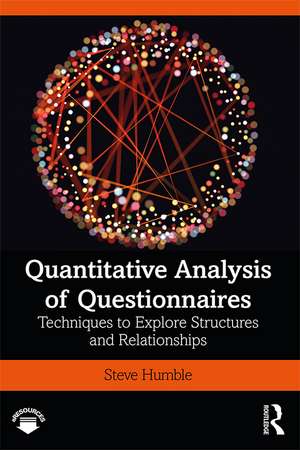Quantitative Analysis of Questionnaires: Techniques to Explore Structures and Relationships
Autor Steve Humbleen Limba Engleză Paperback – 23 ian 2020
Bringing together the techniques required to understand, interpret and quantify the processes involved when exploring structures and relationships in questionnaire data, Quantitative Analysis of Questionnaires provides the knowledge and capability for a greater understanding of choice decisions. The ideal companion for non-mathematical students with no prior knowledge of quantitative methods, it highlights how to uncover and explore what lies within data that cannot be achieved through descriptive statistics. This book introduces significance testing, contingency tables, correlations, factor analysis (exploratory and confirmatory), regression (Linear and Logistic), discrete choice theory and item response theory.
Using simple and clear methodology, and rich examples from a range of settings, this book:
- Provides hands-on analysis with data sets from both SPSS and Stata packages
- Explores how to articulate the calculations and theory around statistical techniques
- Offers workable examples in each chapter with concepts, applications and proofs to help produce a higher quality of research outputs
- Discusses the use of formulas in the appendix for those who wish to explore a greater mathematical understanding of the concepts
Quantitative Analysis of Questionnaires is the ideal introductory textbook for any student looking to begin and or improve statistical learning as well as interpretation.
| Toate formatele și edițiile | Preț | Express |
|---|---|---|
| Paperback (1) | 207.96 lei 6-8 săpt. | |
| Taylor & Francis – 23 ian 2020 | 207.96 lei 6-8 săpt. | |
| Hardback (1) | 1001.07 lei 6-8 săpt. | |
| Taylor & Francis – 20 ian 2020 | 1001.07 lei 6-8 săpt. |
Preț: 207.96 lei
Nou
39.81€ • 43.25$ • 33.46£
Carte tipărită la comandă
Livrare economică 21 aprilie-05 mai
Specificații
ISBN-10: 0367022834
Pagini: 232
Ilustrații: 37 Line drawings, black and white; 25 Halftones, black and white; 124 Tables, black and white; 72 Illustrations, black and white
Dimensiuni: 156 x 234 x 20 mm
Greutate: 0.43 kg
Ediția:1
Editura: Taylor & Francis
Colecția Routledge
Locul publicării:Oxford, United Kingdom
Public țintă
Postgraduate and UndergraduateCuprins
- Illustrations; About the author; About the book; Chapter 1. Introduction; Chapter 2. Statistical Significance and Contingency Tables; Chapter 3. Factor analysis : Exploratory; Chapter 4. Correlation and Linear Regression; Chapter 5. Factor analysis: Confirmatory; Chapter 6. Regression: Logistic; Chapter 7. Making choices: Discrete choice theory; Chapter 8 – Item response theory; Appendix; References; Index
Notă biografică
Descriere
Bringing together the techniques required to understand, interpret and quantify the processes involved when exploring structures and relationships in questionnaire data, Quantitative Analysis of Questionnaires provides the knowledge and capability for a greater understanding of choice decisions. The ideal companion for non-mathematical students with no prior knowledge of quantitative methods, it highlights how to uncover and explore what lies within data that cannot be achieved through descriptive statistics. This book introduces significance testing, contingency tables, correlations, factor analysis (exploratory and confirmatory), regression (Linear and Logistic), discrete choice theory and item response theory.
Using simple and clear methodology, and rich examples from a range of settings, this book:
- Provides hands-on analysis with data sets from both SPSS and Stata packages
- Explores how to articulate the calculations and theory around statistical techniques
- Offers workable examples in each chapter with concepts, applications and proofs to help produce a higher quality of research outputs
- Discusses the use of formulas in the appendix for those who wish to explore a greater mathematical understanding of the concepts
Quantitative Analysis of Questionnaires is the ideal introductory textbook for any student looking to begin and or improve statistical learning as well as interpretation.
